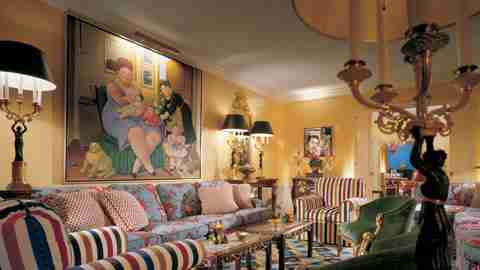Color Field on Fifth
View Slideshow

Beauty is a very eclectic affair," observes the owner of a Manhattan pied-à-terre. Among the elements in the entrance hall of this prominent patron, art collector and former gallery owner are an Empire mirror, a Chinese red-lacquered table, a gilt Austrian chandelier, a painting by Robert Indiana and a mock-Roman sculpture by Michael Lucero. The result is an atmosphere of deliberate disparity, at once provocative and inviting. "My husband and I have never been ones to settle for a single style," she says. "The world is far too rich and varied a place."
It was New York–based interior designer Thomas Britt whom they called on to instill a semblance of order into their wide-ranging tastes. The clients and Britt had worked together before, on the couple's estate in Westchester County, as well as on an apartment for their son. This time, however, the parameters were slightly different. "For the country house we asked Tom for interiors that wouldn't compete with our art collection," recalls the wife. "But in the New York apartment we wanted to achieve more of a blend. We were after a bold interior for bold art."
As it happens, the change of register was just what the designer hoped to hear. "I can never repeat the same look from one project to another," insists Britt, "and thank goodness they didn't ask me to. What I did wish to repeat was the opportunity to work with absolutely first-rate art."
While the postwar building lacked any significant interior architectural details, the distribution of the rooms was agreeable, and Britt was spared the task of knocking down walls. There was another important detail that remained constant—the apartment's sweeping views over Fifth Avenue and Central Park.
"My clients are great lovers of color," Britt explains. "There was never any talk of subtle, monochromatic tones—on the contrary, we were going for a striking palette." In the living room, he spread an antique geometric-patterned dhurrie atop a sisal carpet. He upholstered the sofas in a floral fabric, a pair of club chairs in stripes and the nineteenth-century gilt "rope" chairs in a rich green velvet. The walls are painted a primrose yellow and are hung with works by Fernando Botero, Ron Janowich and Sam Messer.
The room's daring mixture of color and texture would have been perhaps overwhelming had Britt not resorted to his signature love of balance and symmetry in the placement of furniture and objects. Flanking the Botero above the sofa are a pair of fine Swedish Empire mirrors. Over the two Regency consoles are four Thomire candelabra, which he converted into lamps. There are a pair of Chinese low tables with mother-of-pearl inlay. "Above all, I'm drawn to the classical world," says Britt, "and that's a world in which symmetry reigns. An interior without a balanced composition too often falls into chaos."
In the adjacent library, Britt paneled the walls in Italian stone pine to create a sense of warmth. Seeking continuity between it and the living room, he used more Chinese mother-of-pearl-inlaid low tables and nineteenth-century gilt chairs. On the floor is a Bessarabian carpet. The focal point, however, is a floral still life by David Hockney.
Britt's inventive blending of diverse objects is most evident in the guest bedroom. "It's a fun, interesting space," he says. Here, he intermingled a Portuguese headboard, Indian silver chairs and a grouping of classical and Empire engravings.
"Collecting is a part of my soul," admits the wife. It is a passion that she shares with her husband but that she inherited from her mother—and a number of the latter's acquisitions now grace both of her residences. Among the heirlooms in the New York apartment are a collection of Meissen porcelain, which fills two Louis XV cabinets in the dining room, and an abstract work by Robert Delaunay that hangs above the Biedermeier sideboard.
It is the combination of art and objects from mother and daughter, in fact, that gives the apartment an added resonance, a feeling that a selective eye has chosen these works with criteria and care. It makes sense to hang a Kenneth Noland near the Delaunay, and after examining the Meissen, one understands the numerous works of modern and contemporary ceramics by Picasso, Philip Maberry and Ron Nagle, among others, that are found throughout the rooms.
"This is not a space in which anything goes," says Thomas Britt. "I tried to create a classical scheme from a host of disparate elements, and in the end, I think we revealed the logic in all this eclecticism."